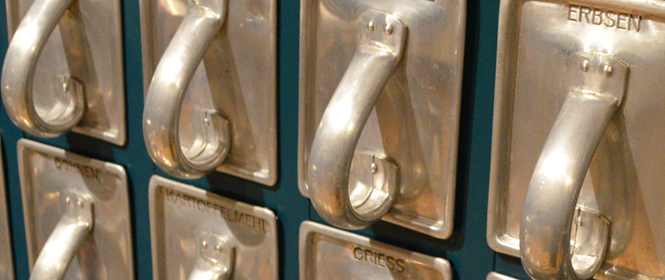
Time-saving and efficient – the Frankfurt Kitchen
Stefanie Müller | 2 April 2019
In the early days of the Weimar Republic there was an enormous shortage of housing. To safeguard the social peace the right to a “healthy dwelling” was anchored in the constitution. It was above all the municipalities that began around 1924 to implement extensive housing programmes, which included among other things the optimisation of home furnishings. In this DHM blog Stefanie Müller writes about a classic of the times: the “Frankfurt kitchen” designed by Margarete Schütte-Lihotzky.
That little bit of housework… still quite enough to do is what many people are thinking now. Fortunately, practical and increasingly clever household appliances alleviate the chores and save time. Many of these household aids that we now take for granted first came about in the 1920s, and among them is the modern built-in kitchen, whose origin dates back to the Weimar Republic. Even then rationalisation of the workload and time-saving methods were already the driving force behind many technical innovations. But not only that: the Weimar Republic also offered the opportunity for a cultural modernisation of society. However, what does that have to do with household and kitchen?
New time – New solutions
The young republic was faced with serious challenges, one of which was the huge housing shortage, especially in the cities. In order to tackle the disastrous hygienic problems and social conditions, the state sprang into action and began financing major building projects. This was the case in Frankfurt am Main, where Ernst May (1886-1970) was put in charge of the urban planning office in 1925. With the support of the municipal authorities he wanted to turn people’s living space into an affordable and yet high quality site for the good of the masses. Like many modern architects, May counted on standardisation, new materials and new construction methods, as well as on industrial serial production. Not only the process of construction, but also the design of the flats and especially the kitchens were to become more rational. To achieve this, May brought the young Viennese architect Margarete Schütte-Lihotzky (1897-2000) into his team. Inspired by the kitchens in railway dining cars, she studied the exact movement sequences that occur in housekeeping. Every step of the work was timed with a stopwatch to determine the most efficient design of the kitchen. In 1926 she presented the results of her studies – the so-called Frankfurt kitchen.

Margarete Schütte-Lihotzky (1897-2000) © ullstein bild – Imagno
Innovation in the smallest space
What Schütte-Lihotzky came up with was a ca. six square metre kitchen that was no longer thought of as a kitchen/living space, but merely as a workroom. Furnishings for a room of this size did not exist, so the architect developed a modular system for which the furnishings could be produced cost-effectively in large numbers. The design with its numerous practical extras was ground-breaking and even seems modern today.
On the work surface beneath the window there was a hatch through which food scraps could be discarded directly into a rubbish chute. In addition to a double sink the kitchen had a drain board and drip rack so that it was no longer necessary to dry the dishes. The working space could be enlarged by means of pull-out boards affixed to the lower cabinet. Special chutes were developed where provisions could be stored within easy reach. Further comfort was provided by a ventilated food box that served as a kind of refrigerator, a stove with an exhaust hood as well as a cooking box to keep food warm and finish the cooking process. An additional extra was an ironing board that could be pulled down to extend across the entire breadth of the room. The petrol colour used for the kitchen furniture – currently very much en vogue – was based on studies conducted at the University of Frankfurt which showed that the greenish-blue coating helped to keep the flies away. Depending on the available space, the individual modules were arranged in different variations. Between 1926 and 1932 some 10,000 Frankfurt kitchens were installed.

Frankfurter Küche in der Ausstellung „Weimar: Vom Wesen und Wert der Demokratie“ © DHM/I. Desnica
New kitchen – New people
Ernst May, Margarete Schütte-Lihotzky and other modern architects utilised the pioneering spirit of the Weimar Republic to make living healthier, cheaper and more just with the help of new methods and materials, and a new, objective stylistic idiom. The pomp of the imperial age and with it the monarchy itself were considered obsolete. Social housing offered progressive architects the opportunity to visualise the new social conditions in constructivist terms. But in addition that: with their work they also pursued the vision of an intellectual transformation – New Building for the “New Man” and “New Woman”. The now democratic society needed active citizens, but they also needed to be educated. The exterior and interior design of the living space was to play a part in this new mindset. For the growing number of employed women the Frankfurt kitchen meant first of all an easing of the burden, but at the same time it required an adjustment to the new standard furnishings they now encountered. The time they saved was supposed to be used for social commitment and further self-qualification; the clear forms were to foster a clear mind. Margarete Schütte-Lihotzky’s pathfinding design therefore does not simply stand for practical kitchen furniture, but embodies the underlying concept: the idea of the intellectual formation of the residents in the spirit of a new, democratic society.
 © Privat |
Stefanie MüllerStefanie Müller is a historian and art historian specialising in the cultural history of the 20th century. Her latest project was to curate the exhibition “Weimar: The Essence and Value of Democracy” at the Deutsches Historisches Museum. |